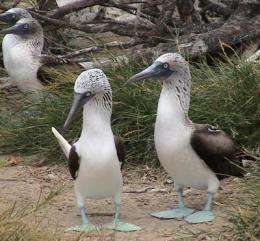Wild animals age too

Until now, the scientific community had assumed that wild animals died before they got old. Now, a Spanish-Mexican research team has for the first time demonstrated ageing in a population of wild birds (Sula nebouxii) in terms of their ability to live and reproduce.
"It was always thought that senescence was something particular to humans and domestic animals, because we have an extended life expectancy", Alberto Velando, lead author of the study and a researcher at the Ecology and Animal Biology Department of the University of Vigo, tells SINC.
However, the idea that wild animals are killed off by predators or parasites before showing signs of ageing has changed "totally" in recent years: "Senescence exists in wild animals' reproduction and living capacity", confirms Velando.
The study, which has been published in the Journal of Evolutionary Biology, used a database stretching back over 30 years to study a population of the blue-footed booby (Sula nebouxii), long-lived birds that inhabit the Pacific coasts of Mexico, the Galapagos Islands and Peru, to determine their ageing patterns.
The results show for the first time that their germline (the DNA sequence passed from one generation to the next) is not damage-free. "The DNA of the sperm of older individuals is damaged. This means their offspring have a greater likelihood of suffering from congenital illnesses", the biologist explains.
Foot colour is key to deterioration
In humans, it has already been shown recently that the children of men aged over 50 or 60 are more likely to suffer from genetic illnesses. "It was thought that this was of no importance in nature, and that it was a defect of our civilisation, since we live longer than a natural lifespan. However, it turns out that this happens in nature too", says Velando.
The colour of these birds' feet changes with age, mirroring the oxidative damage suffered by their sperm. According to the expert, females choose males on the basis of colour, and are less attracted to older males with more faded feet, which prevents their offspring from being affected by genetic mutations.
The study confirms that, in general, middle-aged males have a less deteriorated germline and more colourful feet. Velando says this study helps to shed light on selection patterns, and the evolutionary and growth patterns of populations.
"The study provides us with a new way of looking at what lies behind sexual signals, pointing to the importance of sexual selection in eliminating genetic mutations", the scientist concludes.
More information: Velando, A.; Noguera, J. C.; Drummond, H.; Torres, R. "Senescent males carry premutagenic lesions in sperm" Journal of Evolutionary Biology 24(3): 693-697, March 2011.
Provided by FECYT - Spanish Foundation for Science and Technology


















